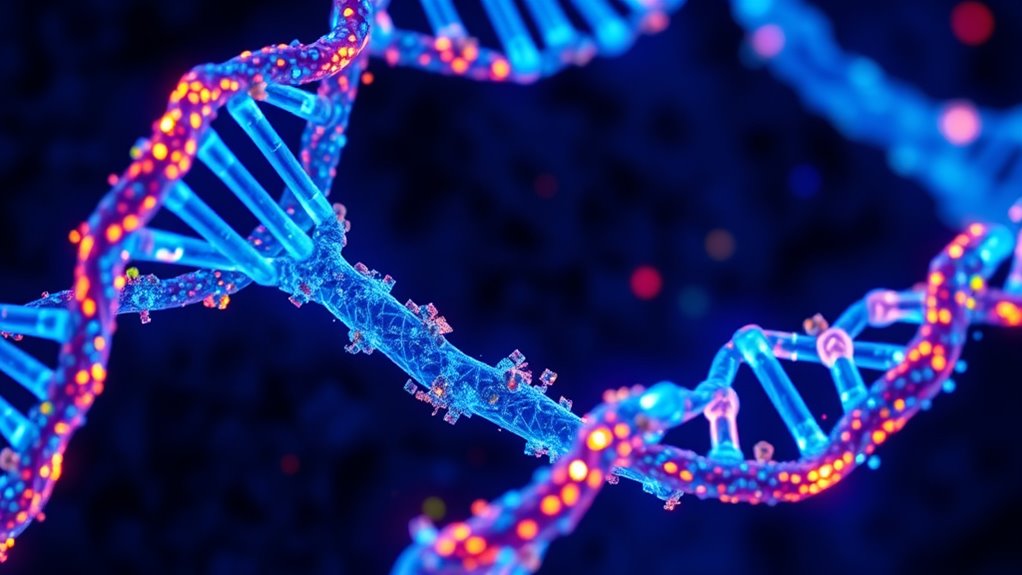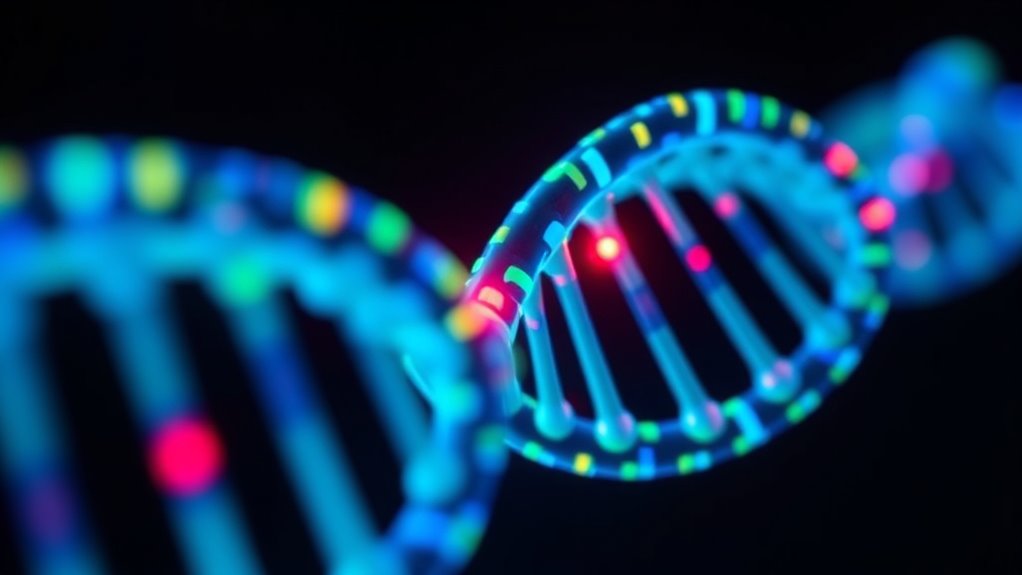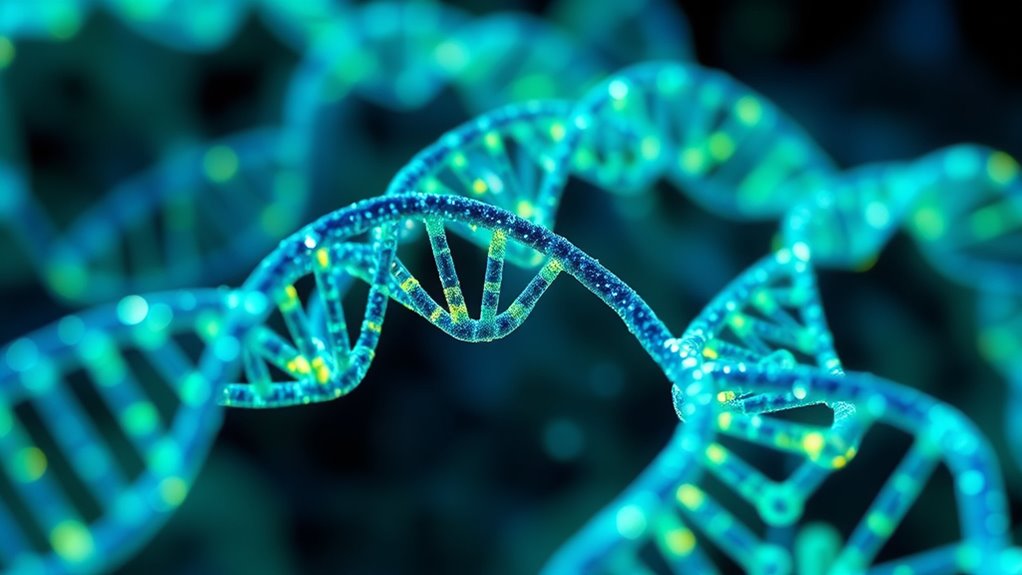CRISPR gene editing uses a guide RNA to direct the Cas9 enzyme to specific DNA sequences, where it acts as molecular scissors to cut the genetic material. The process relies on recognizing PAM sequences to guarantee accurate targeting and avoid off-target effects. Cellular repair pathways then fix the break, allowing gene modifications. Advances in Cas9 variants improve precision and expand possibilities. If you continue, you’ll discover more about how this innovative chemistry can transform disease treatments.
Key Takeaways
- CRISPR uses guide RNA and Cas9 enzyme to locate and cut specific DNA sequences, enabling targeted gene editing.
- The guide RNA directs Cas9 to the target DNA through base pairing, forming a heteroduplex for precise cleavage.
- PAM sequences are essential DNA motifs that guide Cas9 to distinguish target sites from non-target DNA.
- DNA repair pathways like HDR and NHEJ determine whether gene edits are precise or error-prone after Cas9-induced cuts.
- Advances in Cas9 variants improve editing accuracy and expand targeting capabilities, aiding disease research and therapy.
The Components of CRISPR/Cas9 and Their Functions

CRISPR/Cas9 gene editing relies on two main components: guide RNA (gRNA) and the Cas9 enzyme. Cas9 acts as molecular scissors, cutting DNA at specific sites to enable gene editing.
The guide RNA, made of crRNA and tracrRNA, directs Cas9 to the target DNA sequence. When combined, gRNA and Cas9 form a ribonucleoprotein complex that locates and cleaves the DNA.
Cas9 is a large enzyme with 1368 amino acids, divided into recognition and nuclease lobes. The recognition lobe binds the gRNA, while the nuclease lobe contains domains responsible for DNA cleavage. Cas9’s structure is highly conserved across different species, ensuring its functionality in diverse biological contexts. The PAM-interacting domain guarantees Cas9 binds only to DNA with the correct PAM sequence, facilitating precise targeting and cutting of the genetic material.
How Cas9 and Guide RNAs Target Specific DNA Sequences

Guide RNAs direct the Cas9 enzyme to specific DNA sequences by base pairing with the target region. The guide RNA combines crRNA and tracrRNA, forming a hybrid structure that recognizes the DNA.
The crRNA contains a sequence complementary to the target DNA, enabling precise base pairing. The tracrRNA provides a stem-loop structure that interacts with Cas9, stabilizing the complex.
When the gRNA binds to the matching DNA sequence, it forms a heteroduplex within a positively-charged groove on Cas9, facilitating accurate positioning. This interaction relies on electrostatic forces and the formation of the gRNA-DNA heteroduplex, ensuring specificity.
The recognition lobe of Cas9 plays a crucial role in binding both the gRNA and the DNA, guiding the nuclease domains to the correct site for cleavage.
The Role of PAM Sequences in Gene Editing Precision

PAM sequences are crucial for ensuring the accuracy of gene editing because they serve as essential markers that guide the Cas9 enzyme to its target. Cas9 scans DNA for specific PAM motifs before unwinding the strands and checking for guide RNA complementarity. The PAM isn’t part of the guide RNA; it must be immediately downstream of the target site to trigger DNA unwinding and recognition. This requirement helps Cas9 differentiate “self” from “non-self” DNA, preventing accidental cuts in the host genome. Only DNA sequences with the correct PAM are eligible for cleavage, which reduces off-target effects. Different Cas9 proteins recognize different PAMs, influencing target selection. Knowing PAM variability allows you to select appropriate Cas9 variants, increasing editing precision and expanding targeting possibilities across diverse genomes. Recognizing PAM diversity is essential for designing effective and precise gene editing strategies. Additionally, understanding the chemical interactions involved in PAM recognition can further enhance the development of more accurate editing tools.
Cellular DNA Repair Pathways Shaping Gene Editing Outcomes

When a double-strand break (DSB) occurs in DNA, the cell activates specific repair pathways to fix the damage. These include homologous recombination (HDR), which uses a DNA template for precise editing, and non-homologous end joining (NHEJ), which quickly joins broken ends but often creates insertions or deletions (indels). Microhomology-mediated end joining (MMEJ) and single-strand annealing (SSA) also repair DSBs but are less common in CRISPR applications. The pathway chosen depends on factors like the cell cycle, sequence context, and external influences. Understanding these pathways is crucial for designing effective gene editing strategies. NHEJ tends to dominate, leading to random mutations, while HDR offers accurate edits. Understanding these pathways helps you influence gene editing outcomes, especially when aiming for precise correction versus gene disruption. Additionally, cell cycle regulation plays a significant role in determining which repair pathway is activated, affecting the efficiency and accuracy of gene editing techniques.
Advances in CRISPR Variants for Enhanced Specificity and Versatility

Recent advances in CRISPR technology have led to the development of diverse Cas9 variants that enhance both specificity and versatility. High-fidelity Cas9 mutants like SpCas9-HF and HypaCas9 reduce nonspecific DNA interactions, lowering off-target effects while maintaining efficiency. These engineered Cas9 enzymes achieve this by modifying amino acids involved in DNA binding, which minimizes unintended cleavage. Variants such as SpCas9-NG and xCas9 expand the range of recognizable PAM sequences, allowing access to previously unreachable genomic sites. Coupling Cas9 with artificial inhibitory domains or using nickase versions improves precision by reducing unintended cuts. Additionally, engineering guide RNAs with chemical modifications or internal tweaks boosts targeting accuracy, stability, and safety. Ongoing research into off-target effects continues to improve the safety profile of gene editing techniques.] These innovations enable more precise, flexible gene editing, opening doors for broader therapeutic and research applications. Together, they represent a significant leap toward safer, more effective genome manipulation.
Challenges in Delivery, Safety, and Ethical Considerations

Delivering CRISPR components to specific tissues remains a major obstacle in developing safe and effective therapies. You face challenges choosing between viral vectors like AAV, physical methods such as electroporation, or nonviral options like liposomes.
Crossing barriers like the blood-brain barrier to target certain organs complicates delivery, especially for non-liver tissues, where efficiency drops. Delivering multiple components, like Cas9 and sgRNAs, adds complexity.
Scaling up these methods for widespread use while maintaining precision is tough. Safety concerns include off-target effects, which can cause unintended genetic changes, and immune responses that may lead to inflammation or rejection.
Ethical issues, such as germline editing and equitable access, demand careful regulation. Overcoming these hurdles is essential for realizing CRISPR’s full therapeutic potential.
Frequently Asked Questions
How Does CRISPR Distinguish Between Target and Non-Target DNA?
You might wonder how CRISPR tells apart target from non-target DNA. It uses PAM sequences next to the target, and only recognizes DNA with specific PAMs.
The system then forms a crRNA-DNA heteroduplex, guaranteeing it matches the target sequence.
If the PAM is missing or mismatched, CRISPR won’t activate.
This combination of PAM recognition and precise base pairing ensures it targets only the intended DNA, avoiding mistakes.
What Factors Influence the Efficiency of HDR Versus NHEJ?
You should know that several factors influence HDR and NHEJ efficiency. For HDR, the donor DNA concentration, homology arm length, and cell cycle stage are essential.
Meanwhile, NHEJ’s speed and activity throughout the cell cycle give it an advantage. Cell type variability and mechanistic competition also matter.
Can CRISPR Be Used to Edit Multiple Genes Simultaneously?
Imagine you’re editing a complex playlist with multiple songs at once—that’s what multiplex CRISPR does for genes. Yes, you can target multiple genes simultaneously using different guide RNAs, which speeds up research and reveals gene interactions.
Although efficiency decreases with more targets, advances like pre-designed gRNA libraries help. This technology allows you to study gene networks and disease models more effectively, making your work more precise and all-encompassing.
What Are the Most Common Off-Target Effects Observed in CRISPR Editing?
You want to know the common off-target effects in CRISPR editing. Usually, unintended DNA cuts lead to small insertions or deletions, called indels, disrupting gene function.
Point mutations and larger structural changes like inversions or translocations also occur. These off-target effects happen because Cas9 sometimes tolerates mismatches between the sgRNA and DNA, especially in regions with high similarity.
This tolerance can cause unpredictable mutations and impact genome stability.
How Are CRISPR Components Delivered Into Specific Cell Types?
You want to know how CRISPR components are delivered into specific cell types. You can use physical methods like electroporation or microinjection to directly introduce them.
You might opt for viral vectors such as AAV or lentivirus to target particular cells.
Non-viral methods like lipid or polymer nanoparticles can also be tailored for specific cell targeting.
Additionally, cell-penetrating peptides help deliver CRISPR components precisely into your desired cells.
Conclusion
Understanding CRISPR’s chemistry shows how precise gene editing becomes possible, making therapies for diseases more attainable. While some believe CRISPR could cure all genetic disorders, it’s vital to remember that delivery, safety, and ethics still pose challenges. Scientific evidence suggests careful development is imperative to avoid unintended effects. So, trust in ongoing research, but stay cautious—CRISPR’s power must be used responsibly to truly benefit humanity.









